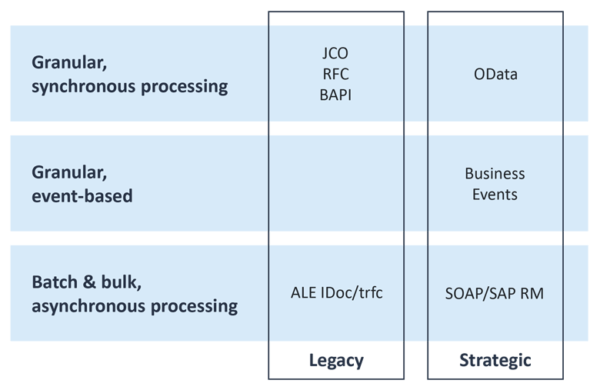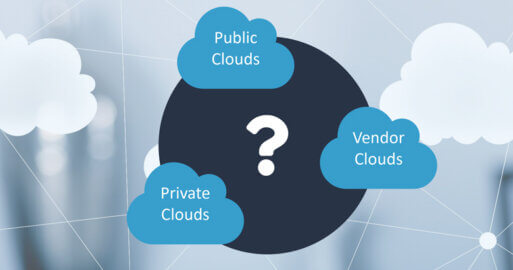Bye, Bye IDoc? What interface technologies will SAP S/4HANA offer, compared to SAP ECC?

SAP’s new ERP system S/4HANA still includes some established interface technologies. However, there are also several new SAP interface technologies. When migrating to S/4HANA, your integration team will need to start by examining the interfaces to every single endpoint. They will need to make changes and even research suitable alternatives. Essentially, in each case they will need to weigh up whether to continue to use the now legacy interface technologies, or to find an option which promises greater flexibility and future security. Find out what to look out for, and how SEEBURGER can help you take the work out of network.
Will all the old, familiar SAP interfaces still be supported?
SAP integration specialists are familiar with terms like IDoc, ALE, RFC, BAPI and JCO. These stand for the tried and tested SAP interface technologies and are ‛SAP standards’, although not universal standards. Companies using an SAP ERP system have successfully used these standards to integrate their various business programmes for many years. In fact, IDoc has been around since it was first introduced as an add-on for SAP R/2 back in 1979.
Now that SAP S/4HANA is here, SAP is having to do a balancing act. Users expect SAP to have introduced innovative ways of supporting newer technologies. However, they are also hoping that SAP S/4HANA will continue to support the old ways. After all, it would be nice just to take the old ERP system out, plug in S/4HANA and get going straight away.
That is not going to happen. Here are four reasons why:
- The number of IDocs available has been reduced in comparison to SAP ECC, although there should still be enough available for most cases.
- Several of the IDocs available have undergone changes, as the database model underpinning SAP S/4HANA is different. This has had an effect on some of the fields within the familiar IDocs.
- Some business application programming interfaces (BAPI) are now on a blacklist.
- For security reasons, the IDoc and ALE technologies are not available through SAP S/4HANA Cloud Essentials (the Multi-Tenant Cloud Edition).
There, the least you will have to do is to check every single interface. And you will need to make some changes or even search for suitable alternatives.
Which new SAP interfaces are right for my organisation?
Fortunately, there are interfaces in SAP S/4HANA which can be used for a wide range of integration needs. For some, you will still be able to use the legacy technologies IDoc, ALE, RFC and BAPIs, if these are available in your version of S/4HANA. Below are three further integration innovations that have been added to SAP S/4HANA:
- OData
This is a REST API based on the OData protocol. It is good for synchronous integration needs. This covers most of the business documents you will need automatically created, however, is not really suitable for batch or bulk processing. - SAP Reliable Messaging (SAP RM)
This uses a SOAP-based API and is suitable for asynchronous and batch processing. SAP has extended the metadata in the header to include Quality-of-Service details, ExactlyOnce and ExactlyOnceInOrder. This technology also caters for a number of message types supported by SAP, and is a good substitute for IDoc/ALE. It is an interesting option for B2B integration scenarios. - Business Events
This has also been available as an add-on for SAP ECC since 2020. Used alongside an integration platform, this uses event-driven architecture (EDA) to trigger an action. System elements subscribe to an event (an example may be changing a data record). Once this event is detected by the system, this can trigger a defined action, such as updating a related data record, or sending a defined person an e-mail notification. This would be an example of using Business Events to synchronise fine-grain data.
This chart summarises the various interfaces and their possible applications:

Is there an easier way?
The classification into legacy versus strategic interface technologies in particular shows that SAP S/4HANA users must be on their guard. Admittedly, both the old, proven technologies and the newcomers are likely to endure. Together, they offer mature and coordinated overall concepts such as using IDoc/ALE for message control, error handling, etc. Nevertheless, it seems unlikely that SAP will develop their legacy interfaces further. Therefore, many organisations are going for the convenience of an integration platform, such as SEEBURGER’s Business Integration Suite, which
- already covers the full range of SAP S/4HANA integration needs, including the old, established SAP technologies
- makes it easy to switch to the newer, strategic technologies at a later date, which still supporting the classic technologies.
The SAP One Domain model currently offered by SAP does not offer a common/canonical data model. That’s not its goal. Instead, it is primarily a unified data model to share master data across SAP applications. To this end, an entry like ‘supplier’ is given core attributes, which are shared to all SAP applications. The effects of this model on transactional data (including the relevance for A2A & B2B integration scenarios) is not yet clear. A particularly interesting case will be integration with non-SAP applications.
Equally interesting will be the introduction of SAP Graph, which can be expected at the end of 2021. SAP Graph aims to make it possible to ‘abstract’ an entire SAP landscape via a REST API. This allows you to focus on content (e.g., the status of a business transaction across multiple SAP applications) by consuming a central API instead of orchestrating a query across all applications. This innovation is important for enabling quick and easy app development in an SAP landscape, for ensuring various SAP landscapes (e.g. cloud and on-premises) are in sync, and a number of other A2A and B2B integration scenarios.
Find out more about how SEEBURGER can help you integrate SAP S/4HANA, and have a look at our blog posts covering the things you need to consider in this mammoth task. For one thing’s for sure: S/4HANA integration is best left to the experts.
Thank you for your message
We appreciate your interest in SEEBURGER
Get in contact with us:
Please enter details about your project in the message section so we can direct your inquiry to the right consultant.
Written by: Thomas Kamper
Thomas Kamper, SVP Strategic Product Management, is responsible for strategic product initiatives related to all SEEBURGER’s business integration technology and solutions. The focus is currently on API solutions and Big Data. In addition, he is responsible for solutions that enable organizations to master challenges of visibility and to control the proper execution of digitalized business processes. Thomas rejoined SEEBURGER December 2017. Before, he worked for many years as a hands-on interim manager and business advisor supporting C-level executives within software and cloud service providers to make their strategic product initiatives successful.





